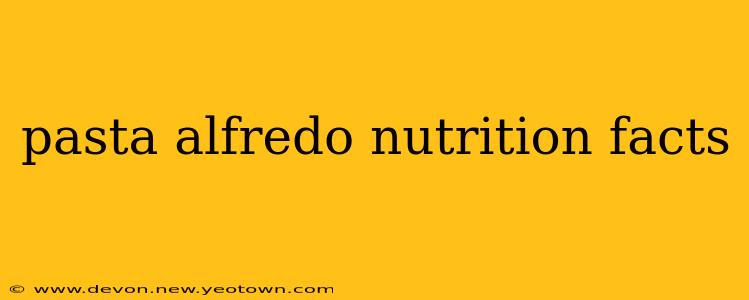Decoding the Delicious: A Deep Dive into Pasta Alfredo Nutrition Facts
Pasta Alfredo. The creamy, dreamy, decadent dish that whispers promises of comfort food heaven. But before you twirl another forkful of this luscious pasta, let's unravel the nutritional truth behind its rich and satisfying flavor. Understanding the nutritional profile of your favorite meals is key to making informed choices about your diet, and Pasta Alfredo is no exception. This isn't about demonizing deliciousness; it's about appreciating it with full awareness.
Our culinary journey begins with a look at the foundational elements: pasta and the Alfredo sauce itself. The nutritional content can vary wildly depending on the ingredients used. Let's break it down:
What are the main ingredients in Pasta Alfredo?
Pasta Alfredo, at its most basic, consists of pasta (usually fettuccine or other long noodles) and a creamy sauce made primarily from butter, Parmesan cheese, and heavy cream. Variations often include garlic, salt, pepper, and sometimes even chicken broth for added depth of flavor.
How many calories are in a serving of Pasta Alfredo?
This is a tough one to answer definitively, as portion sizes and ingredient choices heavily influence the calorie count. A typical serving of restaurant-prepared Pasta Alfredo can easily clock in at 600-800 calories or even more. Homemade versions, depending on the quantity of cream and cheese, can range significantly, from around 400 calories for a lighter version to upwards of 700 calories for a richer one.
What are the macronutrients in Pasta Alfredo?
The macronutrient breakdown is largely dominated by fats and carbohydrates. The heavy cream and butter contribute significantly to the fat content, while the pasta provides the carbohydrates. Protein levels are relatively moderate, primarily coming from the Parmesan cheese. A typical serving might contain:
- High in Fat: Much of the fat is saturated, which should be consumed in moderation.
- High in Carbohydrates: These come mainly from the pasta and contribute to the dish's caloric density.
- Moderate in Protein: While not a significant source of protein, the Parmesan cheese provides a decent amount.
Is Pasta Alfredo high in cholesterol?
Yes, Pasta Alfredo is relatively high in cholesterol due to the presence of butter, cheese, and cream. Individuals with high cholesterol should consume it sparingly.
What are the vitamins and minerals in Pasta Alfredo?
While not a nutritional powerhouse in terms of vitamins and minerals, Pasta Alfredo does offer some benefits:
- Calcium: Parmesan cheese is a good source of calcium, crucial for bone health.
- Vitamin A: Trace amounts of Vitamin A can be found in the dairy products used.
Is Pasta Alfredo a healthy meal option?
Let's be honest: Pasta Alfredo, in its traditional, rich form, isn't exactly a health food champion. The high fat, calorie, and cholesterol content make it a meal best enjoyed occasionally as part of a balanced diet.
Are there healthier versions of Pasta Alfredo?
Absolutely! Healthier alternatives can be created through mindful ingredient substitutions:
- Reduce the cream: Use half-and-half or even milk instead of heavy cream to lower the fat content.
- Lighten up the cheese: Reduce the amount of Parmesan cheese or opt for a lower-fat variety.
- Add vegetables: Incorporating vegetables like spinach, mushrooms, or broccoli adds nutrients and fiber, increasing the nutritional value.
- Whole wheat pasta: Using whole wheat pasta boosts the fiber content.
Enjoy your Pasta Alfredo responsibly, savoring it as an occasional treat rather than a staple in your diet. By making informed substitutions and being mindful of portion sizes, you can indulge in this creamy classic without completely derailing your healthy eating goals.

